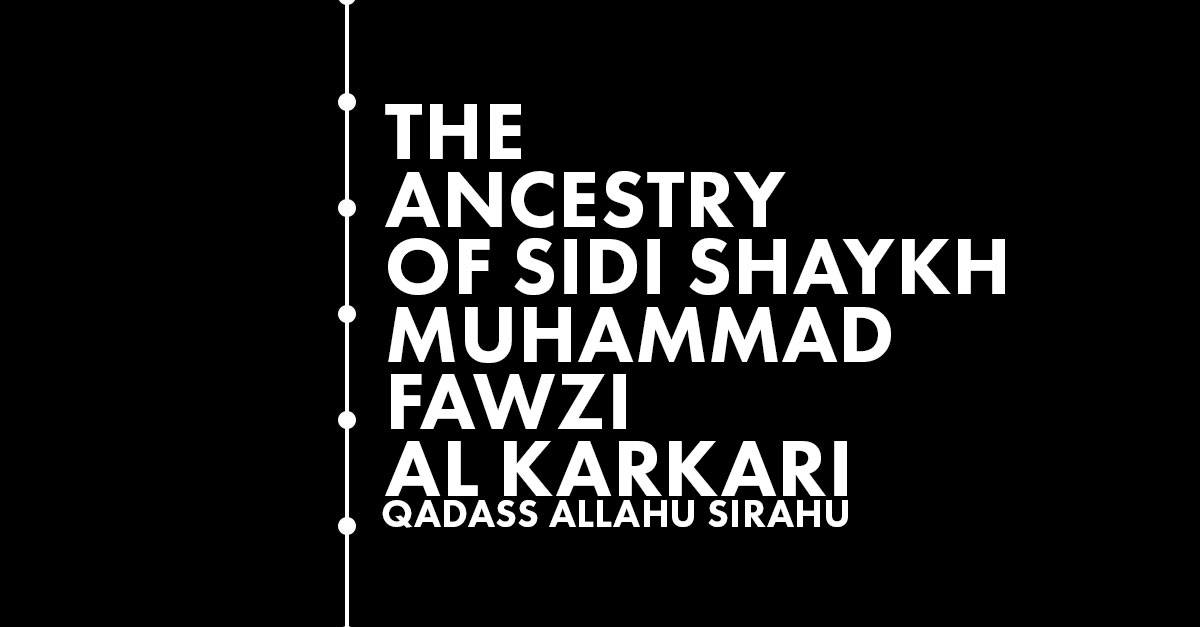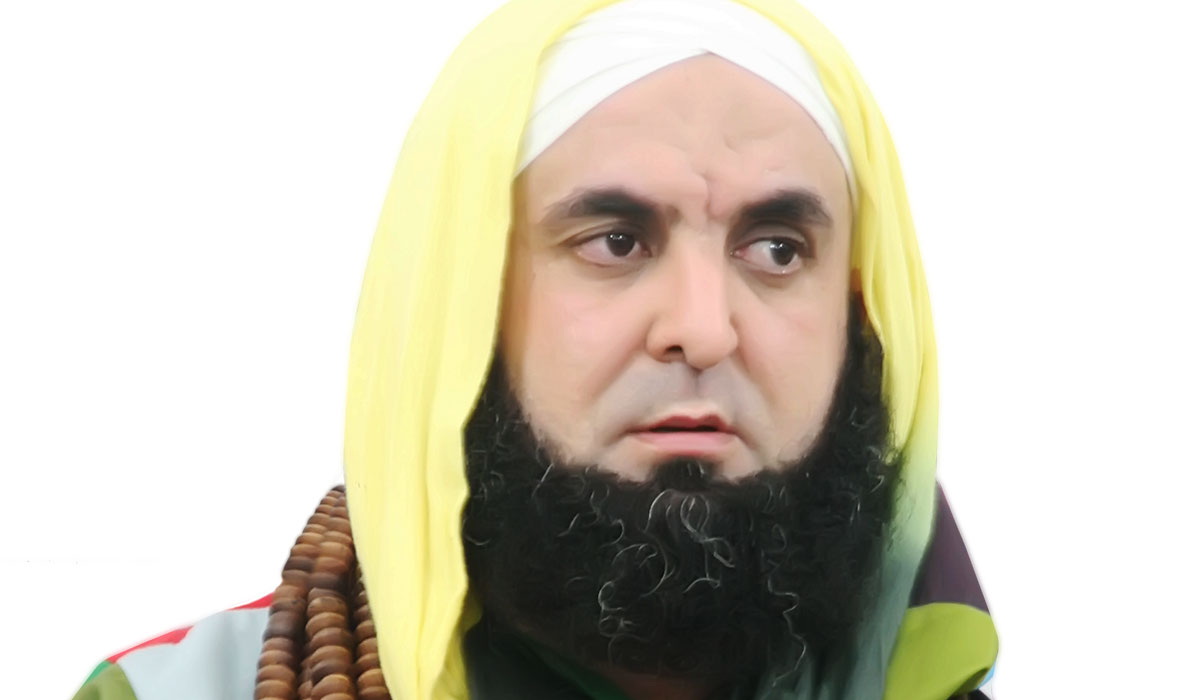بسم الله الرحمن الرحيم
و الصلاة و السلام على أشرف المرسلين
و على اله و اصحابه أجمعين
His name and lineage:
He is the Imam, the pious, devout, hidden between the people of the Masters of Allah, ocean of gnosis and mysticism, secret source of divine knowledge (ma’rifa), our Master and uncle and Shaykh of our Shaykh, the Knower of Allah, Mawlay al-Hassan al-Karkariy, son of Knowing by Allah Mawlay at-Tahir al-Karkariy, son of Knowing by Allah Mawlay Muhammad al-Fardiy, son of Knowing by Allah Mawlay at-Tayyib, son of Knowing by Allah Mawlay Muhammad ibn al-Qaddour Wakîliy, through which the line goes back to Sayidinâ wa Mawlana RassoûliLlâh ﷺ.
His initiatory chain of succession:
He received (ra) the Supreme Knowledge of his father, Shaykh Knowing by Allah (swt) Mawlay at-Tahir al-Karkariy, who received by the Knowing by Allah Sidi Ahmad Al-‘Alawiy, who received by the knowing by Allah Sidi Muhammad ibn al-Habib al-Boûzîdiy, who received by the knowing by Allah Sidi Muhammad ibn al-Qaddour Wakîliy, and it goes back to the sanad of sayidinâ Aliy (karramAllâhu wajhah), who received from sayidinâ RassouliLlâh ﷺ, who received from sayidinâ Jibreel (‘ alaihi s-salam), who received from the Lord Almighty, exalted.
It is therefore (ra) a Sharif (noble descendant of the Prophet ﷺ) of blood relationship and spiritual bond. And if among the rapporteurs of Hadith, there is no greater pride than to bring the Hadith of his own father, who himself refers to his father, it is the same for the science of hearts and the Maqam of Ihsan. So it’s a huge honor for a man to pass from the heart of his father, according to his grandfather, which was the case of Sidi al-Hassan (ra), who took the divine knowledge of his own father Sidi at-Tahir (qaddassAllâhu sirrahu), inheritor to the secret (sirr) of Sidi Ahmad al-‘Alawiy (rahimahuLlâhu ta’ala). Sidi at-Tahir was also the Shaykh of his own father Sidi Muhammad al-Fardiy, the grandfather of Sidi al-Hassan, which is reported many karâmâtes(wonders) … Sidi Muhammad al-Fardiy is also the son of Mawlay at- Tayyib, who himself is the eldest son of the great Knower of Allah, nicknamed Abu l-Mawahib (the man with extraordinary karâmâtes), Sidi Muhammad ibn al-Qaddour Wakîliy, may Allah be pleased with them all and make us benefit from them and their benefits, Amin.
His birth:
He was born (ra) in 1358 AH (1936. J-C) and received the pious education from both his parents noble young participant from the meetings of dhikr and spiritual teachings.
The cause of his entry into the Way:
Although Sidi al-Hassan (rahimahuLlâhu ta’ala) had the privilege of growing up with his father in a zâwiya filled with aspirants to fuqara ‘and Knowers by Allah, his early years were not marked by a particularly interest of the way … until his brother Sidi Ahmad (rahimahullaah) accomplished the spiritual retirement in khalwa and received the sirr. So he went to meet him to ask his advice, and found him in state of euphoria, drunk with the secret he had just received. This condition caused the spark that ignited sidi al Hassan’s heart of an unbearable desire of the divine. He left in a place, in short distance from the zawiya, known for abound in caves and caverns, where he devoted himself exclusively to the dhikr al-Ism Moufrad (Allah), majdhoûb totally sucked in him, during a month … until the veil was lifted for him, and then wherever he laid his eyes, he saw appear the Ism Allah written in letters of light. When he returned to his father and Shaykh Sidi at-Tahir, he brought him into the blessed khalwa, and then Allah gave him great Fath and revealed to him His secrets and the wonders of His malakoûte.
His career and his patience in the pursuit of science:
He was (ra), through the companionship of his Shaykh, exemplary behavior, patient and firm on the path, he never turned away from his goal. He relied on his Shaykh whenever he encountered an obstacle and so benefited in the best possible way, his experience and his spiritual flow (madad). During the period when he had to go to Algeria to work, he did not hesitate to travel to Temsemên where his Shaykh was, bearing the harshness of travel for the only purpose of obtaining the answer to one or two questions, before returning immediately to Algeria. He used to meet his father at the market near his display. He then questioned him about the secrets of the Divine Names and recounting his visions and unveilings, then return to Algeria immediately after receiving the replies to his questions. We can easily imagine the difficulties posed by such a trip and patience and perseverance must be shown to carry it out, without considering the financial aspect that either was not negligible, nor the risks deal with bandits and wild beasts that littered the road … all this in order to acquire knowledge, and not just any science because it is the most noble and distinguished: science by Allah ﷻ, responding to the order contained in the verse: “Know that there is no god but Allah” [s47 v19].
Allah has given him a laduni knowledge (science from Allah) and has made him a complete knower, seeing His unity (jam) in His diversity (farq) and His diversity in His unity, having tasted the secrets of the Divine Names (Asmâ ‘ Ul-Husna) as well as different visions of divine manifestations. Sîdî al-Hassan (radiAllâhu ‘anhu) was thus a scholar by the “Handful of Light” (al-qabdat ul-noûrâniyya) as well as states of that handful, a holder of the science of numbers and letters, he was an ocean without shore in the immensity of Haqiqa.
His moral qualities:
Sîdî al-Hassan (radiAllâhu ‘anhu) was endowed with the moral qualities of people accomplished in divine knowledge, clothed with virtues and merits, rid of what is vile and abject, he always displayed good humor, A great patience, and gave without fear of poverty. On this subject it is said that, on his return to the market, He was used to giving alms to everything he had, without looking at what he gave or to whom he gave it, That he no longer has a penny in his pocket, and then he went home as he had come. He is also told that his house never emptied guests or people in need, and treated everyone in the best way possible.
He forgave and did not care about the people, was gentle with the adults and anxious for the children. No victim of injustice resigned himself to him without finding him willing to help him, and no unjust crossed his path without being put back in its place. He was an example in terms of modesty, he dressed himself of what he found and sat where he found a place. In his eyes the people were all equal to each other, and among the examples of his modesty the fact that he was seen talking to the child by giving him the same attention as the adult. His behavior breathed joyfulness and gaiety, he acted by indulgence and gentleness, but also knew how to show intransigence and hardness when he had to. And if we wanted to make an inventory of all its qualities, we could not … we will content ourselves with what has been said here.
How he acceded to the status of Shaykh:
When his father and Shaykh Sidi at-Tahir al-Karkariy (qaddassAllâhu sirrahu), noted the excellence and deep knowledge of the Divine Names of his son and student Sidi al-Hassan (rahimahumâLlâh) he granted him the idhn (permission) making him a Shaykh able to educate and guide aspirants to Allah, this before his death and in the presence of all. Among the witnesses of this octroiement idhn Figure the imam and Knower by Allah (swt) Sidi as-Sayid (ra), who was a great Mouhaqqiq who followed the teachings of Sidi at-Tahir, which otherwise instructed to wash his body after his death may Allah make them all mercy. After the death of Sidi at-Tahir, in 1976, Sidi al-Hassan became the Sheikh of the Tariqa … however he lived hidden until death, and very few people were aware of the place that he had.
It is related on this subject that when sîdî at-Tâhir died (rahimahuLâh), a murid presented himself to the zāwiya as having been sent by a Sheykh of a known tariqa, who would have said to him: “If you seek the Knowledge of Allâh And of the Ism, then rest with the sîdî at-Tâhir in Temsemên “. But when this murid came on the spot, he was told that sîdî at-Tâhir had died … and sîdî al-Hassan, heir to the secret (sirr) of his father, welcomed him into the zāwiya. The Mourid then said to him: “I have come to find Mawlay at-Tahir wishing to gain access to the Knowledge of Allah, and now I will have to seek his heir so that he may guide me to Him. Sidi al-Hassan (radiallahu ‘anhu) then replied: “If Allah granted you to see a clear vision, you would find him standing before your eyes …”.
The man then set out from whence he came, and if he had been sincere in his search, Allah would have enabled him to recognize in him the Sheykh he was asking.
Despite the fact that he was not really revealed and known to people during his lifetime for his high spiritual level, some were able to take advantage of his teachings, and even through his access to a pure and exquisite Divine Knowledge, Through the visual testimony, and among them is our Sheykh sîdî Muhammad Fawziy al-Karkariy (radiAllâhu ‘anhu), who accompanied him for two consecutive years, during which he acceded to everything that sîdî al-Hassan (qaddas Allahu sirrahu) had to convey. The Sheykh said in this regard, addressing the assembly: What is here, indicating his heart, is here, and it indicates the heart of our Sheykh sîdî Muhammad Fawziy (radiAllâhu ‘anhu).
His karâmâtes:
When we speak of karâmâte, we obviously do not forget that the true karâma is indeed the istiqâma, that is to say rectitude and righteousness in relation to what Allâh ﷻ Revealed, added to the permanent vision of the Beloved ﷺ, as well as the firmness of attachment to all divine stations. However, there is no harm in mentioning here some physical karâmâtes that Allâh made appear by the hand of sîdî al-Hassan (radiAllâhu ‘anhu). Among these, it may be mentioned that one day the sister of his wife had come to visit them at home and had remained there three months. When she wanted to go home, he asked her to stay a little longer if she wanted, but she was afraid that the water would enter her house and damage the furniture … and so she decided go. Sîdî al-Hassan (radiAllâhu ‘anhu) told her to stay until morning, and he would inform her of the condition of his dwelling. The next morning he informed her by unveiling (kachf) that everything in her house was in good condition, except for a tray which was used to transport the tea service and whose color had changed because of moisture… She remembered the tray which she had put there and forgotten for a long time, and when she returned home she found her house in the condition he had described to her (qaddas Allahu sirrahu). Among his karam also the fact that he had precisely determined the place where he would be buried, and he prayed at this place two units of prayer. And in general, we consider that sîdî al-Hassan is entirely karâma, and among his greatest karâmâtes, undoubtedly his mourid sîdî Muhammad Fawziy al-Karkariy (radiAllâhu ‘anhu).
His death:
Shortly before his death (radiAllâhu ‘anhu), the heir to his sirr sîdî Muhammad Fawziy al-Karkariy (radAllâhu’ anhu) told him about his awakened vision of his death and what would happen exactly at that time. He replied: “In shâ’a Allâh, it will be so …” And indeed, everything went exactly in the way seen by sîdî Muhammad Fawziy (qaddas Allâhu sirrahu). He died in the year 1428 of the Hejire (2006), after having prayed al-‘ishâ in group, in his house on his bed, he went to join his Lord, repeating Ism al -Moufrad: “Allâh … Allâh … Allâh …”. He lost consciousness for a while, then, when he recovered his mind, he charged his children to settle for him the affairs which he had under way, and his mind did not leave until he had given all the prescriptions Which he had to give. May Allah grant him mercy and grant him the highest degrees, Amin.
The Shaykh Mawlay al Hassan (radiAllahu ’anhu)



